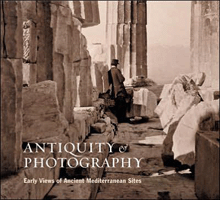

| |
| Photograph as Artifact | Volume 59 Number 1, January/February 2006 |
|
Extended online-only version by Mark Rose |
|
Assessing the achievements of nineteenth-century pioneers
In 1839, the scientist François Arago introduced Louis-Jacques Mandé Daguerre's new way of capturing images to an excited audience in Paris. Arago himself was enthusiastic about it: "To copy the millions of hieroglyphs that cover even the exterior of the great monuments of Thebes, Memphis, Karnak, and others would require decades of time and legions of draftsmen. By daguerreotype, one person would suffice to accomplish this immense work successfully." That dream was never achieved, but the recording of archaeological monuments began almost as soon as Daguerre's and other photographic techniques were devised. More than 100 such images, made between 1840 and 1880, appear in Antiquity & Photography. Early Views of Ancient Mediterranean Sites (2005: J.Paul Getty Museum, $65.00 hardcover).

The volume consists of four long essays--an overview, assessments of early practitioners Joseph-Philibert Girault de Prangey and William James Stillman, and an in-depth look at Athens. An additional two "portfolios" complement the essays, presenting many images with basic information rather than a detailed discussion. The first portfolio is a sample of works by early French photographers and Briton Francis Frith in Egypt. The second has images by various photographers in Rome and Pompeii, as well as a number produced by the French firm of Braun, Clément, and Cie at various sites.
In the initial overview essay, by Claire Lyons of the Getty Research Institute, the discussion of photography's impact occasionally slips from assessment to advocacy: "The camera played a decisive role in the rediscovery of antiquity, particularly in the lands surrounding the Mediterranean...." Unarguably, photography pushed things along, but the rediscovery had been going on for a couple of centuries by the time of Daguerre's invention. And I might not agree that, "Archaeology, like photography, is both art and science, a journey through time that arrests history in incremental moments." Archaeology ought to be about understanding how past cultures worked, not just freezing moments in time. But the essay does a great job of showing the increasing reliance on photographic documentation. This theme is pursued in the essay devoted to Athens, contributed by John K. Papadopoulos of UCLA, that considers early photographs as both ideal images (when they were made) and sources of historical information (today).
Among the first photographers was Joseph-Philibert Girault de Prangey (1804-1892), whose work is reviewed by photographic consultant Lindsey S. Stewart. The last of an aristocratic French family, he was, according to acquaintances, eccentric and a bit crusty. But Girault de Prangey was also intellectually wide-ranging. He raised rare plants and exotic birds and studied the Islamic architecture of southern Spain (making use of his abilities as a fine draftsman). From 1842 to 1845, he traveled the eastern Mediterranean, taking 800 to 1,000 daguerreotypes of sites in Greece, Turkey, Lebanon, and Egypt. Although his superb images are the first taken of many of these sites, he is not well known because daguerreotypes proved to be a dead-end technology, the Betamax of early photography. Each daguerreotype was a unique image, a silver coated copper plate, that couldn't be duplicated easily for printing. Englishman William Henry Fox Talbot's photographic method perfected a year later, however, used a negative that could be used to make many copies of a single image.
The American William James Stillman (1828-1901) is known today for his The Acropolis of Athens (1870), an album of 25 views of the Acropolis and its monuments and sculptures. A complex individual, his careers included "painter, editor, diplomat, spy, art critic, amateur archaeologist, political commentator, and journalist," according to Andrew Szegedy-Maszak of Wesleyan University. A devoted disciple of the English art critic John Ruskin, Stillman rubbed shoulders with the likes of Henry Wadsworth Longfellow and Oliver Wendell Holmes. Brilliant, he was nonetheless open to beliefs in spiritualism. Even less to his credit, his own writings suggest he paid scant or only intermittent attention to his wife, Laura Mack, who eventually took her own life. It was after her death that Stillman undertook photographing the Acropolis. He had earlier disdained photography, calling it "a rude, inefficient and cumbersome apparatus and process for field work." Now, he embraced it. Szegedy-Maszak suggests that Stillman's approach to the Acropolis went beyond that of his contemporaries and, simply put, that The Acropolis of Athens "portrays the Acropolis allegorically as a symbol of liberty." That may seem farfetched at first, but the album begins with long view of the entire Acropolis and then spirals in, coming closer with each image. The next to last photograph is of a battered, but still recognizable and beautiful sculpture of the goddess Victory; last is a sculptured frieze block from the Parthenon showing the Panathenaic procession, a symbol of Greek democracy. Given Stillman's own mindset and his known support for nationalist causes in Hungary, Italy, and Crete, this analysis seems likely. It puts his work on a higher plane than that of many of his contemporaries whose vision was based on commercial prospects.
Antiquity & Photography is an engaging book, both in text and images, and is certainly of interest to students of early photography and the history of archaeology in the classical world, especially Greece, and Egypt. The essays are polished and thought provoking, the fine images well reproduced. But the book does have limitations. About half of the images are of Athens. Most of the remaining images are either of Egypt (a scattering of sites) or Italy (essentially Rome and Pompeii). Perhaps more could have been done with the "portfolio" approach, letting more images speak for themselves. After all, one daguerreotype is worth...well, a lot of words.
Mark Rose is executive and online editor of ARCHAEOLOGY.
Click here for ARCHAEOLOGY's bookstore.
© 2006 by the Archaeological Institute of America archive.archaeology.org/0601/reviews/photograph.html |
Advertisement

Advertisement






